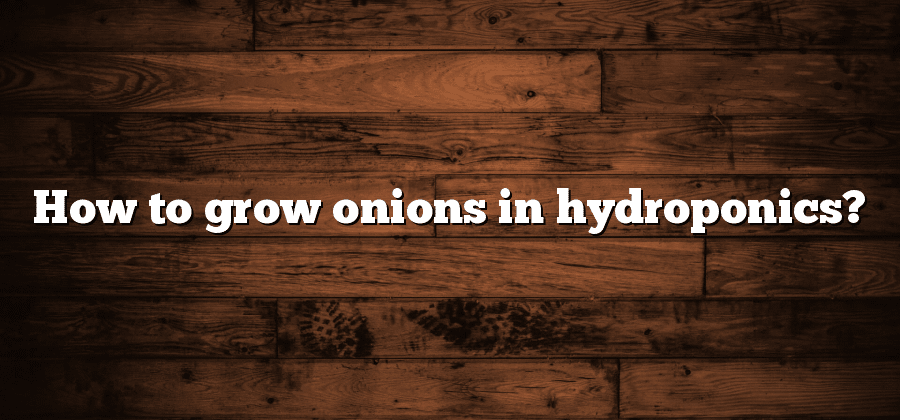Selecting the Right Onion Varieties
When it comes to selecting the right onion varieties for your hydroponic setup, there are a few key factors to consider. Firstly, you need to think about the specific characteristics you desire in your onions, such as size, flavor, and storage capacity. Different varieties offer different qualities, so it’s important to do your research and find the ones that best suit your requirements.
Additionally, take into account the climate and growing conditions of your region. Certain onion varieties thrive in cooler temperatures, while others prefer warmer climates. By selecting varieties that are well suited to your local weather patterns, you can maximize your chances of achieving successful onion growth in your hydroponic system. Remember, a well-informed choice in selecting onion varieties will set the foundation for a productive and rewarding hydroponic onion garden.
Providing Adequate Lighting for Onions
To ensure the healthy growth and development of onions in a hydroponic system, adequate lighting is crucial. Onions require an ample amount of light to photosynthesize and produce energy, which is essential for bulb development. Without proper lighting, your onion plants may become weak, elongated, and fail to produce large, flavorful bulbs. Therefore, it is essential to provide the correct type and intensity of light to optimize onion growth in a hydroponic setting.
When it comes to selecting lighting for onions, it is important to consider two factors: the light spectrum and the light intensity. Onions require a spectrum of light that closely resembles natural sunlight, typically in the range of 400 to 700 nanometers. This broad spectrum ensures that the plants receive all the necessary wavelengths for photosynthesis. Additionally, the intensity of light should be sufficient to meet the plant’s energy requirements. For onions, a light intensity of 1000 to 2000 micromoles per square meter per second (µmol/m²/s) is typically recommended. By providing the right spectrum and intensity of light, you can help your onion plants thrive and achieve optimal bulb growth.
Creating an Ideal Nutrient Solution
Selecting the right nutrient solution is crucial for the success of your hydroponic onion cultivation. The nutrient solution serves as a substitute for soil, providing all the essential minerals and elements necessary for healthy plant growth. When creating an ideal nutrient solution for onions, it is important to understand the specific nutrient requirements of this particular plant.
Onions have different nutrient requirements at different stages of growth. In the early vegetative stage, a nutrient solution with higher nitrogen levels is necessary to promote leaf development. As the plant transitions into the bulb formation stage, a nutrient solution with reduced nitrogen but higher phosphorus and potassium content is preferable. Balancing these macronutrients along with the appropriate micronutrients will ensure optimal growth and bulb development in your hydroponic onion crop. Remember to monitor the nutrient solution closely, adjusting the composition as needed to maintain consistent growth and yield.
Choosing the Correct Hydroponic System
The process of choosing the correct hydroponic system is crucial for successful onion cultivation. With numerous options available, it is essential to consider factors such as space availability, cost, and the specific requirements of the onion variety being grown. Each system has its advantages and disadvantages, so it is important to weigh these factors to make an informed decision.
One popular hydroponic system for growing onions is the Nutrient Film Technique (NFT). This system involves a continuous flow of nutrient-rich water over the plant roots, providing them with a consistent supply of nutrients. NFT is known for its efficiency in water and nutrient usage, making it a cost-effective option for onion growers. Another option is the Deep Water Culture (DWC) system, where the roots of the onion plants are submerged in nutrient solution. This method allows for high oxygen levels and promotes faster growth. However, it requires more initial investment due to the need for an air pump and additional equipment. In summary, selecting the ideal hydroponic system requires careful consideration of the specific needs and resources available, ensuring the best possible environment for onion growth.
Preparing the Hydroponic Medium for Planting
In order to ensure successful growth of your hydroponic onions, it is crucial to properly prepare the medium before planting. This step sets the foundation for the plants to thrive and receive the necessary nutrients.
Firstly, choose a high-quality hydroponic medium that is well-draining and provides adequate aeration for the roots. Rockwool and coconut coir are popular choices amongst hydroponic growers due to their excellent water retention abilities. Before use, thoroughly rinse the medium to remove any potential contaminants and adjust its pH level to create an optimal environment for the plants. This can be done by soaking the medium in a solution of water and a pH adjuster, such as phosphoric acid or potassium hydroxide, until the desired pH is achieved. Once the medium is prepared, it is ready for planting the onion seedlings or transplants.
Remember, the success of your hydroponic onion system heavily relies on the proper preparation of the hydroponic medium. Neglecting this step can lead to poor growth, nutrient deficiencies, and even plant diseases. So take the time to implement these essential preparatory measures, and set your hydroponic onions up for vigorous growth and abundant yields.






